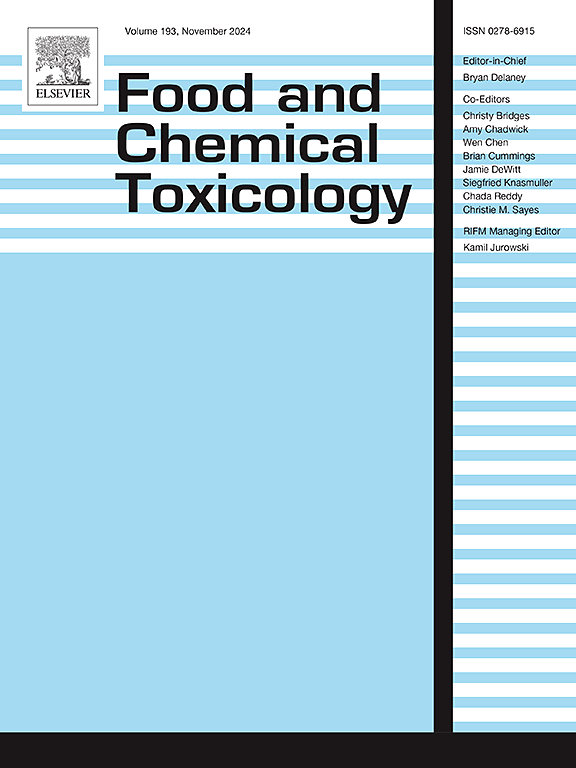具有多靶点抗癌潜力的聚合苯并咪唑-姜黄素纳米复合物的药代动力学、生物分布和口服毒性研究
IF 3.9
3区 医学
Q2 FOOD SCIENCE & TECHNOLOGY
引用次数: 0
摘要
本研究研究了聚乙二醇化β-环糊精-姜黄素功能化苯并咪唑纳米复合物(BMPE-Cur)对瑞士白化小鼠的多靶点抗癌作用。分别以0.5至2.5 g/kg的单剂量口服BMPE-Cur,并连续28天分别以5、10和25 mg/kg的剂量重复给药,评估急性和慢性毒性。采用LC-MS分析BMPE-Cur的药代动力学(PK)和生物分布特征。毒理学评估显示,BMPE-Cur可耐受高达2.5 g/kg的剂量,与1.5 g/kg剂量相关的中度脏体和生化改变,而重复给药会引起剂量依赖性的组织病理学、血液学和生化改变。5-10 mg/kg范围内的剂量耐受性良好,上述参数的一般正常化表明。PK分析显示游离BMPE和BMPE- cur获得的最大血浆浓度(Cmax)值相似。然而,后者使达到Cmax (Tmax)的时间加快了50%,同时伴随的是较长的停留时间和较低的清除率。BMPE- cur与人体血液具有良好的血液相容性,在相同浓度范围内溶血率比游离BMPE低46.58% ~ 99.96%。这些发现强调了BMPE-Cur良好的药代动力学和生物相容性,同时确定了潜在的人类翻译的安全治疗剂量。本文章由计算机程序翻译,如有差异,请以英文原文为准。
Insights into the pharmacokinetics, biodistribution, and oral toxicity of a polymeric benzimidazole – Curcumin nanocomplex with a multitarget anticancer potential
The current study investigates the oral toxicity of a PEGylated β-cyclodextrin-curcumin functionalized benzimidazole nanocomplex (BMPE-Cur) with multitarget anticancer potential in Swiss albino mice. Acute and chronic toxicities were evaluated after oral administration of BMPE-Cur in single doses ranging between 0.5 and 2.5 g/kg and repeated dosing of 5, 10, and 25 mg/kg for 28 consecutive days, respectively. Pharmacokinetic (PK) and biodistribution profiles of BMPE-Cur were analyzed by LC-MS. The toxicological assessments revealed that BMPE-Cur was tolerable up to 2.5 g/kg, with moderate organosomatic and biochemical alterations associated with doses >1.5 g/kg, whereas repeated dosing induced dose-dependent histopathological, hematological, and biochemical alterations. Doses within a range of 5–10 mg/kg were well tolerated, as indicated by the general normalization of the mentioned parameters. PK analysis revealed a similar value of maximum plasma concentration (Cmax) attained by the free BMPE and BMPE-Cur. However, the latter accelerated the time to reach Cmax (Tmax) by 50 %, concomitant with longer residence time and lower clearance rate. BMPE-Cur also presented excellent hemocompatibility with human blood, with 46.58 %–99.96 % lower hemolysis than free BMPE within the same concentration range. These findings underscore the favorable pharmacokinetics and biocompatibility of BMPE-Cur while identifying safe therapeutic doses for potential human translation.
求助全文
通过发布文献求助,成功后即可免费获取论文全文。
去求助
来源期刊

Food and Chemical Toxicology
工程技术-毒理学
CiteScore
10.90
自引率
4.70%
发文量
651
审稿时长
31 days
期刊介绍:
Food and Chemical Toxicology (FCT), an internationally renowned journal, that publishes original research articles and reviews on toxic effects, in animals and humans, of natural or synthetic chemicals occurring in the human environment with particular emphasis on food, drugs, and chemicals, including agricultural and industrial safety, and consumer product safety. Areas such as safety evaluation of novel foods and ingredients, biotechnologically-derived products, and nanomaterials are included in the scope of the journal. FCT also encourages submission of papers on inter-relationships between nutrition and toxicology and on in vitro techniques, particularly those fostering the 3 Rs.
The principal aim of the journal is to publish high impact, scholarly work and to serve as a multidisciplinary forum for research in toxicology. Papers submitted will be judged on the basis of scientific originality and contribution to the field, quality and subject matter. Studies should address at least one of the following:
-Adverse physiological/biochemical, or pathological changes induced by specific defined substances
-New techniques for assessing potential toxicity, including molecular biology
-Mechanisms underlying toxic phenomena
-Toxicological examinations of specific chemicals or consumer products, both those showing adverse effects and those demonstrating safety, that meet current standards of scientific acceptability.
Authors must clearly and briefly identify what novel toxic effect (s) or toxic mechanism (s) of the chemical are being reported and what their significance is in the abstract. Furthermore, sufficient doses should be included in order to provide information on NOAEL/LOAEL values.
 求助内容:
求助内容: 应助结果提醒方式:
应助结果提醒方式:


